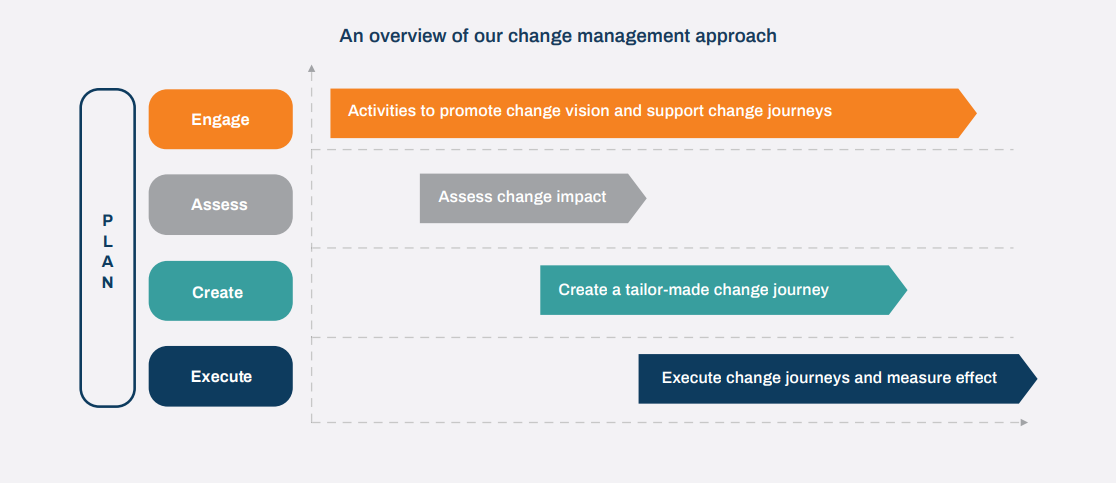The manufacturer's journey requires trusted data-driven insights for sustained success. Getting people to want to adopt the technology and trust the output and insights is critical to that success.
But how do you do that? In this blog, we’ll walk you through:
- Creating proper ownership across your organisation
- Addressing the ‘what's in it for me?’ question
- The recommended approach to managing change
Creating proper ownership across your organisation
If you want your people to be proactive in making change, then you need them to take ownership of it. Not because they have to, but because they want to.
You can help your people take ownership by removing the fear from change – people don’t like change as it can be seen as too big, scary or hard. But what if the change happened in small steps – that can help alleviate the fear. So, try to shift the mindset of your people to one of change being gradual rather than ‘big bang’.
Also, involve your people in the project early and often. You can do this by:
- Including them in your vision for change
- Explaining the reasons and meaning behind your vision for change
- Asking for their opinion on the change and valuing their expertise
This will bring you one step closer to getting their ownership.
Addressing the ‘what's in it for me?’ question
 People usually only want to know one thing when it comes to change – what’s in it for me? So, build this into your overall messaging.
People usually only want to know one thing when it comes to change – what’s in it for me? So, build this into your overall messaging.
Make sure you can explain:
- What the change is about
- How it will impact your employees
- What your employees will have to do
The way you communicate this change to your people is important too – you need them engaged and bought into your vision if you want your project to be a success.
- Adopt the right tone with your employees – this takes on extra importance when communicating something as a big as digital transformation
- Build a small sample group of employees – be varied in terms of job role, length of services, age, etc so you can gather a range of viewpoints
- Explain your motives and purpose for digital transformation – explain to the sample group your reasons and aims for digital transformation and ask for their viewpoint. Would it make a difference to their lives? If it wouldn’t make much difference, what would make them care? And what would inspire them enough to change their stance?
- Create inspiring stories to boost employee engagement – use your findings from the sample group to create real-life examples that help your employees understand your reasoning for the project and see it’s a decision worth pursuing. For example, automating a process that makes your employees daily lives easier
The recommended approach to managing change
A structured change management approach is necessary to stay on track. It ensures time is spent on meaningful activities and allows space to identify and address gaps throughout the initiative.
This formal yet practical approach also ensures processes are integrated into a more holistic business transformation method. Now the steps within your change management process are repeatable - perfect for ensuring they’re consistently applied on more initiatives throughout the organisation.

Purpose of each stage:
- Plan – assess the readiness for change and plan for change and value realisation
- Engage – establish and promote your change vision
- Assess – understand and define the change, with the aim of analysing its impact on your business
- Create – create change journeys per role and define training needs, and value benchmarks and measures
- Execute – execute change and secure value realisation
It’s generally recommended that the business change management team is resourced internally rather than completely outsourced. This is because people are more likely to listen and adopt changes from colleagues rather than external contractors.
We’d also recommend your internal change management team work alongside a consultancy to advise leading practice and mitigate risks and common issues. This is particularly important for less experienced teams.
Here are some of the mains benefits of following a structured change management approach:
- A better understanding of risk, timing and contribution to the initiative and strategic objectives
- More efficient resource usage
- Improved transparency, accountability and governance
- A people-centric change initiative which engages employees in the transition
- Enhanced value realisation, thanks to proactive change and benefits management which ensure the relevant parts of the business change
- Improved engagement and communication between senior management and the business
Read more about our recommended roadmap to people and business change by clicking on the button below.

